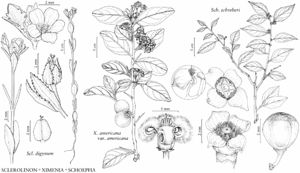Ximenia
Sp. Pl. 2: 1193. 1753.
| Taxon | Illustrator ⠉ | |
|---|---|---|
 | Sclerolinon digynum Ximenia americana var. americana Schoepfia schreberi | John Myers Yevonn Wilson-Ramsey |
Shrubs or small trees, long-shoots vegetative, short-shoots fertile, arising from leaf-axils of long-shoots, each paired with a thorn. Stems glabrous. Leaves densely fascicled on short-shoots, subcoriaceous, surfaces glabrous or puberulent. Inflorescences: bracts 0 or 2–4 at pedicel bases. Pedicels present. Flowers: sepals minute, not accrescent in fruit; petals glabrous or puberulent abaxially, densely hairy adaxially; ovary elongate-conic or lanceoloid. Drupes yellow, orange, pink, or red, ellipsoid, oblong-ovoid, or globose. x = 12.
Distribution
Fla., Mexico, West Indies, Central America, South America, Asia, Africa, Indian Ocean Islands, Pacific Islands, Australia, subtropical and tropical regions
Discussion
Species 10 (1 in the flora).
Fruits of Ximenia americana and X. caffra Sonder are eaten either raw or cooked. In India, oil from the seeds of X. americana is used as a ghee substitute and the wood is used in place of sandalwood (see R. A. DeFilipps 1968 for other economic applications). Anticancer compounds known as ribosome-inactivating proteins have been found in X. americana (C. Voss et al. 2006). Long chain acetylenic acids in that species showed potential pesticidal activity (M. O. Fatope et al. 2000).